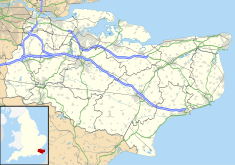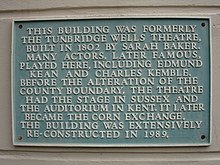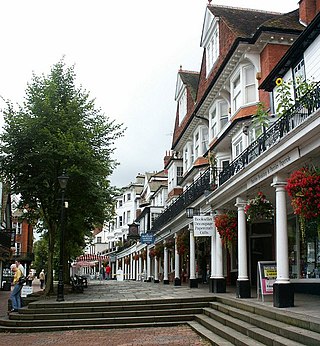
Royal Tunbridge Wells is a town in Kent, England, 30 miles southeast of central London. It lies close to the border with East Sussex on the northern edge of the High Weald, whose sandstone geology is exemplified by the rock formation High Rocks. The town was a spa in the Restoration and a fashionable resort in the mid-1700s under Beau Nash when the Pantiles, and its chalybeate spring, attracted visitors who wished to take the waters. Though its popularity as a spa town waned with the advent of sea bathing, the town still derives much of its income from tourism.

Marquess of Abergavenny in the County of Monmouth, is a title in the Peerage of the United Kingdom created on 14 January 1876, along with the title Earl of Lewes, in the County of Sussex, for the 5th Earl of Abergavenny, a member of the Nevill family.

The Pantiles is a Georgian colonnade in the town of Royal Tunbridge Wells, Kent, England. Formerly known as "The Walks" and the (Royal) "Parade", it leads from the well that gave the town its name. The area, developed following the discovery of a chalybeate spring in 1606, has become a popular tourist-attraction.
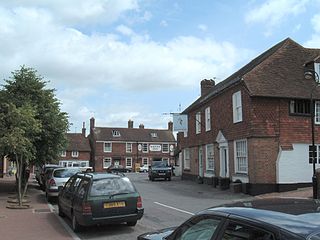
Rotherfield is a village and civil parish in the Wealden District of East Sussex, England. It is one of the largest parishes in East Sussex. There are three villages in the parish: Rotherfield, Mark Cross and Eridge. The River Rother, which drains much of the county and discharges at Rye Harbour, has its source on the south side of the hill on which Rotherfield village is built.

The Hazlitt Theatre and Exchange Studio, also known as the Hazlitt Arts Centre, is a theatre complex in Earl Street in Maidstone, Kent, England. The oldest part of the complex, which is now used as a shopping complex on the ground floor, and as a theatre venue known as the "Exchange Studio" on the first floor, is a Grade II listed building.
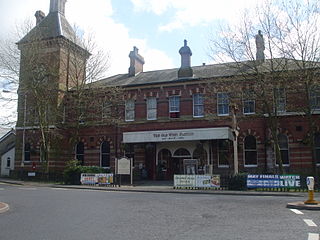
Tunbridge Wells West is a railway station located in Royal Tunbridge Wells, Kent, England. It is one of two railway stations in Tunbridge Wells constructed by rival companies. The other, Tunbridge Wells Central was opened in 1845 by the South Eastern Railway (SER). Tunbridge Wells West was closed to mainline passenger services in 1985. A new station on part of the site has been opened as a heritage railway line opened in 1996. It stands next to the original engine shed which has been restored to use. The line is called the Spa Valley Railway.
Eric Knowles FRSA is a British antiquarian and television personality, whose main interests are in ceramics and glass.
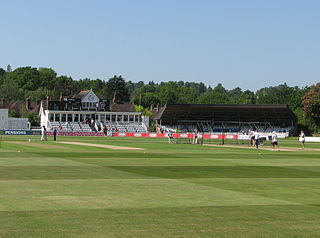
The Nevill Ground is a cricket ground at Royal Tunbridge Wells in the English county of Kent. It is owned by Tunbridge Wells Borough Council and is used by Tunbridge Wells Cricket Club in the summer months and by Tunbridge Wells Hockey Club in the winter. It was opened in 1898 and was first used by Kent County Cricket Club in 1901. Until 2019, the county held the Tunbridge Wells Cricket Week on the ground annually, despite a suffragette arson attack which destroyed the pavilion in 1913.

The Corn Exchange is an events and concert venue located on St Paul's Square in the Castle area of Bedford, Bedfordshire, England. The structure, which was commissioned as a corn exchange, is a Grade II listed building.

O2 Academy Edinburgh is an events and concert venue located in New Market Road in Edinburgh, Scotland. The structure, which was commissioned as a corn exchange, is a Category B listed building.

The Corn Exchange is a commercial building on The Payment in St Ives, Cambridgeshire, England. The structure, which is currently used as an events venue, is a Grade II listed building.

St. Mark's Church is the Church of England parish church for the Broadwater Down area of Royal Tunbridge Wells, Kent, England, in the Diocese of Rochester. Built in the 19th-century Gothic Revival style by Robert Lewis Roumieu, it is a Grade II* listed building.
Tunbridge Wells Cricket Club is an amateur cricket club in Royal Tunbridge Wells, Kent, England. It was founded in 1782 and they play their home matches at the Nevill Ground. As of 2019 they play in the Kent Cricket League Premier Division.
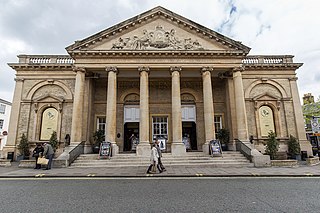
Corn exchanges are distinct buildings which were originally created as a venue for corn merchants to meet and arrange pricing with farmers for the sale of wheat, barley, and other corn crops. The word "corn" in British English denotes all cereal grains, such as wheat and barley. With the repeal of the Corn Laws in 1846, a large number of corn exchanges were built in England, particularly in the corn-growing areas of Eastern England.

The Corn Exchange is a commercial building in King Street, Ipswich, Suffolk, England. The structure, which is currently used as a public events venue, is Grade II listed building.

The Corn Exchange is a commercial complex in the High Street, Rochester, Kent, England. The complex, which was commissioned as a corn exchange and is now used as an events venue, is a Grade I listed building.

The Corn Exchange is a commercial building in Queen Street, Market Rasen, Lincolnshire, England. The structure, which is used as the offices of a firm of charted surveyors, is a Grade II listed building.

The Corn Exchange is a commercial building in the High Street in Thrapston, Northamptonshire, England. The structure, which is now used as the offices of a local firm of auctioneers and estate agents, is a Grade II listed building.

The Corn Exchange is a commercial building in Exchange Square in Beccles, Suffolk, England. The structure, which is now used as a branch of Lloyds Bank, is a Grade II listed building.

The Corn Exchange is a commercial building in the Market Place in Alford, Lincolnshire, England. The structure, which is currently used as a community events venue, is a Grade II listed building.

